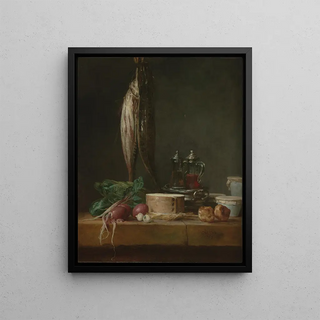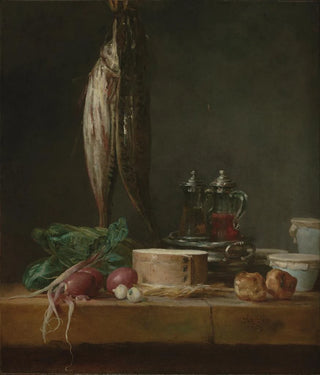Art print | Still life with fish, vegetables, gourds, pots, and bottles on a table - Jean Siméon Chardin


View from behind

Frame (optional)
Art print of Still Life with Fish, Vegetables, Gourds, Jars, and Burettes on a Table - Jean Siméon Chardin – Captivating Introduction
In the rich and fascinating universe of 18th-century painting, Jean Siméon Chardin's "Still Life with Fish, Vegetables, Gourds, Jars, and Burettes on a Table" stands out for its delicacy and striking realism. This composition, which evokes the simplicity and beauty of everyday life, transports the viewer to a world where each object tells a story. The soft light illuminating the items on the table, the textures of the fish and vegetables, as well as the transparency of the burettes, create a calming and contemplative atmosphere. Chardin, an undisputed master of the still life genre, manages to transform ordinary objects into true masterpieces, inviting everyone to rediscover the hidden beauty in the simple things of life.
Style and uniqueness of the work
Chardin's style is characterized by meticulous attention to detail and a subtle color palette. In this still life, he uses earthy tones and touches of light to bring each element to life. The freshly caught fish seem almost to vibrate under the effect of the light, while the carefully arranged vegetables evoke irresistible freshness. The composition is balanced, with each object occupying a precise place that contributes to the overall harmony of the piece. By incorporating everyday elements, Chardin elevates the still life to a higher artistic level, making each painting a reflection on vanity, life, and mortality. This realism, combined with subtle poetry, makes him a pioneer in the field of still life, influencing many artists who followed him.
The artist and his influence
Jean Siméon Chardin, born in 1699 in Paris, is often considered one of the greatest masters of French painting. His career, marked by a constant quest for perfection, was filled with success but also challenges. Chardin managed to establish himself in an artistic environment dominated by rococo and baroque styles by choosing to focus on more humble and everyday subjects. His realistic approach and his ability to capture light and the

Matte finish

View from behind

Frame (optional)
Art print of Still Life with Fish, Vegetables, Gourds, Jars, and Burettes on a Table - Jean Siméon Chardin – Captivating Introduction
In the rich and fascinating universe of 18th-century painting, Jean Siméon Chardin's "Still Life with Fish, Vegetables, Gourds, Jars, and Burettes on a Table" stands out for its delicacy and striking realism. This composition, which evokes the simplicity and beauty of everyday life, transports the viewer to a world where each object tells a story. The soft light illuminating the items on the table, the textures of the fish and vegetables, as well as the transparency of the burettes, create a calming and contemplative atmosphere. Chardin, an undisputed master of the still life genre, manages to transform ordinary objects into true masterpieces, inviting everyone to rediscover the hidden beauty in the simple things of life.
Style and uniqueness of the work
Chardin's style is characterized by meticulous attention to detail and a subtle color palette. In this still life, he uses earthy tones and touches of light to bring each element to life. The freshly caught fish seem almost to vibrate under the effect of the light, while the carefully arranged vegetables evoke irresistible freshness. The composition is balanced, with each object occupying a precise place that contributes to the overall harmony of the piece. By incorporating everyday elements, Chardin elevates the still life to a higher artistic level, making each painting a reflection on vanity, life, and mortality. This realism, combined with subtle poetry, makes him a pioneer in the field of still life, influencing many artists who followed him.
The artist and his influence
Jean Siméon Chardin, born in 1699 in Paris, is often considered one of the greatest masters of French painting. His career, marked by a constant quest for perfection, was filled with success but also challenges. Chardin managed to establish himself in an artistic environment dominated by rococo and baroque styles by choosing to focus on more humble and everyday subjects. His realistic approach and his ability to capture light and the






